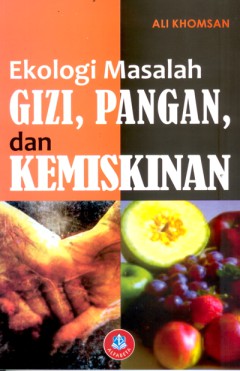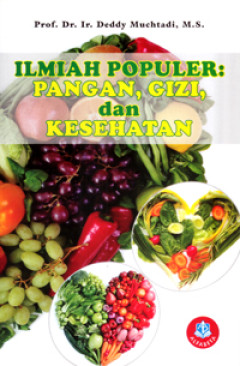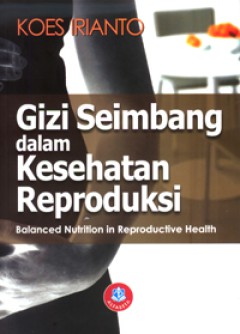Filter by

Bahan Pangan,Gizi dan Kesehatan
- Edition
- -
- ISBN/ISSN
- 978 - 602 - 9328 - 7
- Collation
- X ; 234 P ; bbl illus ; 24 cm
- Series Title
- -
- Call Number
- WA 695 DEW 2014
- Edition
- -
- ISBN/ISSN
- 978 - 602 - 9328 - 7
- Collation
- X ; 234 P ; bbl illus ; 24 cm
- Series Title
- -
- Call Number
- WA 695 DEW 2014

Ekologi Masalah Gizi, Pangan, dan Kemiskinan
- Edition
- -
- ISBN/ISSN
- 978-602-9328-76-9
- Collation
- viii ; 168 p ; bibl ; ilus ; 24 cm
- Series Title
- -
- Call Number
- WD 100 ALI 2012
- Edition
- -
- ISBN/ISSN
- 978-602-9328-76-9
- Collation
- viii ; 168 p ; bibl ; ilus ; 24 cm
- Series Title
- -
- Call Number
- WD 100 ALI 2012

Ilmiah Populer : Pangan, Gizi, dan Kesehatan
- Edition
- -
- ISBN/ISSN
- 978-602-289-172-1
- Collation
- vi ; 222 p ; bibl ; ilus ; 24 cm
- Series Title
- -
- Call Number
- QV 50 DED 2015
- Edition
- -
- ISBN/ISSN
- 978-602-289-172-1
- Collation
- vi ; 222 p ; bibl ; ilus ; 24 cm
- Series Title
- -
- Call Number
- QV 50 DED 2015

Gizi Seimbang dalam Kesehatan Reproduksi: Balanced Nutrition in Reproductive …
- Edition
- -
- ISBN/ISSN
- 978 - 602 - 289 - 08
- Collation
- XXIV ; 808 P ; bbl ilus ; 25 cm
- Series Title
- -
- Call Number
- QV 146 KOE 2014
- Edition
- -
- ISBN/ISSN
- 978 - 602 - 289 - 08
- Collation
- XXIV ; 808 P ; bbl ilus ; 25 cm
- Series Title
- -
- Call Number
- QV 146 KOE 2014

Perbedaan Penggunaan Standar Baru Antropometri WHO-2006 terhadap Peningkatan …
In 2003, WHO formulates multicenter growth references study (MGRS) concept, conducted in 6 countries, with 8440 samples of children living in a healthy environment that allows, then grow in accordance with their genetic potency. Primary health research (Riskesdas) in 2007 were conducted simultaneously in 33 provinces and the assessment of children under-five nutritional status has referred to W…
- Edition
- -
- ISBN/ISSN
- 1410-2935
- Collation
- 11p
- Series Title
- -
- Call Number
- Buletin Penelitian Sistem Kesehatan, 16 (2) : 143-

Pola Asuh Makan pada Balita dengan Status Gizi Kurang di Jawa Timur, Jawa Ten…
According to UNICEF, is direct cause of children under five are malnutrition toddler food consumption is not balanced and the presence of infectious diseases, while indirect factors such as parenting toddlers. The research was conducted over ten months in 2011, in three provinces of East Java, Central Java and Central Kalimantan. The design of the research done crossectional. Quantitative da…
- Edition
- -
- ISBN/ISSN
- 1410-2935
- Collation
- 14p
- Series Title
- -
- Call Number
- Buletin Penelitian Sistem Kesehatan, 16 (2) : 185-

Balita Garis Merah Potret Status Gizi Balita Di Kindisfey Etnik Tehit & Yaben…
- Edition
- -
- ISBN/ISSN
- -
- Collation
- xxii : 280 p ; bibl ; ilus ; 25 cm
- Series Title
- -
- Call Number
- GN 307 SEP 2015
- Edition
- -
- ISBN/ISSN
- -
- Collation
- xxii : 280 p ; bibl ; ilus ; 25 cm
- Series Title
- -
- Call Number
- GN 307 SEP 2015

Pola Konsumsi Pangan, Kebiasaan Makan, dan Densitas Gizi pada Masyarakat Kase…
The purpose of this study was to determine food consumption patterns, eating habits, and its effect on the density of nutrient intake in Kasepuhan Ciptagelar a traditional village community in West Java. Cross–sectional design was implied for this study. A total of 65 eligible households participated in the study. Household’s food consumption data which were used to calculate nutrient d…
- Edition
- -
- ISBN/ISSN
- 0125-9717
- Collation
- 10p
- Series Title
- -
- Call Number
- Penelitian Gizi dan Makanan, 37 (1) : 33-42

Disabilitas pada Lanjut Usia Menurut Status Gizi, Anemia dan Karakteristik So…
It is estimated that Indonesian elderly population will increase to 10.14 percent of the total population in year of 2020 and 16.19 percent in 2030. The consequence of elderly (60 years old or above) will add more burden to government on health care program for this group. As the population grows older, the risk of disability and burden of desease in the population is increasing, therefore gove…
- Edition
- -
- ISBN/ISSN
- 0125-9717
- Collation
- 4p
- Series Title
- -
- Call Number
- Penelitian Gizi dan Makanan, 37 (2) : 87-100

Status Gizi Ibu sebelum Hamil sebagai Prediksi Berat dan Panjang Bayi Lahir d…
Weight and length at birth are the good indicators to evaluate the possibility of survival, growth, and chronic disease as adults. This analysis aims to assess the effect of maternal nutritional status as pre-pregnant and pregnant on birth weight and length of infants at risk of chronic disease in adulthood. The design of this study was a prospective cohort, starting from pre pregnancy, during …
- Edition
- -
- ISBN/ISSN
- 0125-9717
- Collation
- 10p
- Series Title
- -
- Call Number
- Penelitian Gizi dan Makanan, 37 (2) 2014 : 119-128
 Computer Science, Information & General Works
Computer Science, Information & General Works  Philosophy & Psychology
Philosophy & Psychology  Religion
Religion  Social Sciences
Social Sciences  Language
Language  Pure Science
Pure Science  Applied Sciences
Applied Sciences  Art & Recreation
Art & Recreation  Literature
Literature  History & Geography
History & Geography